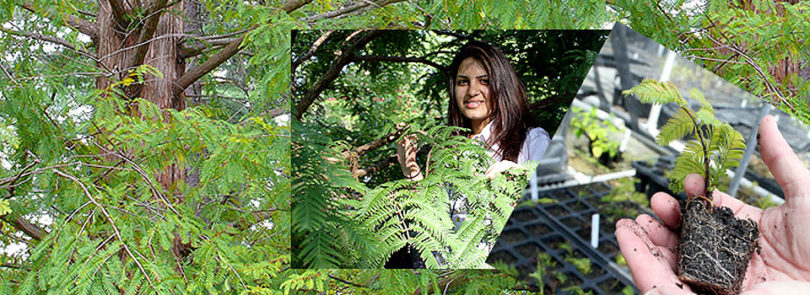Homeowners may soon be able to own a miniature version of a living fossil thanks to a University of Georgia horticulturist and his research team of high school students.
UGA Cooperative Extension specialist Paul Thomas and Houston County student Shireen Dhir successfully propagated rare dwarf dawn redwood trees this past summer. The tiny rooted cuttings are now spreading roots in Thomas’s greenhouse.
The dawn redwood tree was once thought only to exist as a cemented shadow of itself. But a few were found growing in China in the 1940s. Horticulturists brought seeds to the U.S, where it now flourishes throughout the country.
Reaching heights of 100 feet, the tree didn’t make for a good landscape plant. That is until a genetically deficient one was found growing among seedlings in a Georgia nursery.
That dwarf tree is now 13 years old, 11 feet tall and unlikely to get much taller. With its wispy leaves and spreading branches, it’d be an attractive addition to landscapes.
Nurseries would like to sell dwarf dawn redwoods because they conserve space compared to regular dawn redwoods and, like their taller parents, they are pest-and disease-free, requiring little maintenance. They live longer, too, relative to other plant species.
But there is just one problem: There’s only one known dwarf tree.
“You’ve got this living fossil and this cool rare dwarf tree, but the problem is no one’s been able to propagate it,” Thomas said.
As part of his job, Thomas helps Georgia nurseries solve problems. With the dwarf dawn redwood, he was able to figure out how to grow the rare plant and help Dhir learn the world of horticulture.
This past summer, Dhir participated in the UGA College of Agricultural and Environmental Sciences Young Scholars Program, which pairs high school students with UGA mentor-researchers.
With Thomas’ help, she figured out how to propagate the dwarf tree.
Dwarf trees aren’t able to make a lot of hormones, she said, which keeps the trees short and can stop plant breeders from being able to grow more.
With a little patience and a lot of rooting hormones, Dhir and three fellow Young Scholars were able to grow tiny trees from the 60 cuttings they took from the dwarf dawn redwood.
They used two kinds of rooting hormone – one a powder and the other a liquid – and rooted the plants using the highest concentration of the hormones that they could.
“We altered light levels, mist system volumes and hormone application rates to gain success in one month. Normally, it takes six to eight months to complete a typical woody tissue rooting protocol,” she said.
“The students turned out market-ready seedlings in 10 weeks, which is
outstanding,” Thomas said.
The next step is for the nursery owner to make the dwarf dawn redwood available to the public.
Now a freshman at UGA, Dhir plans to study horticulture as a result of her research.





